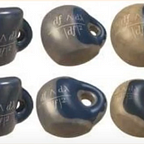A bijective function is both injective and surjective.
A function f is injective, if for every y, there exists at most one (≤ 1) x such that f(x) = y.
In other words, for any y in the codomain, there could either be a unique x such that f(x) = y, or there could be none.
A function f is surjective, if for every y, there exist at least one (≥ 1) x such that f(x) = y.
In other words, for any y in the codomain, there could be x₁, x₂, x₃,… such that f(x₁) = f(x₂) = f(x₃) = y. There can be arbitrarily many of such x, but there needs to be at least one.
We say a function f is bijective, iff it is both injective and surjective. According to the definitions above, it means that for every y in Y, the number of x that satisfy f(x) = y is both ≤ 1 and ≥ 1. Hence, there could only be one of such x.
Now, we give the definition of bijectivity:
A function f is bijective, if for every y in Y, there exists exactly one (=1) x such that f(x) = y.
Note:
- It is not the same as saying “For every x in X, there is exactly one y in Y such that f(x) = y”. This is the definition of a function, not bijectivity.
